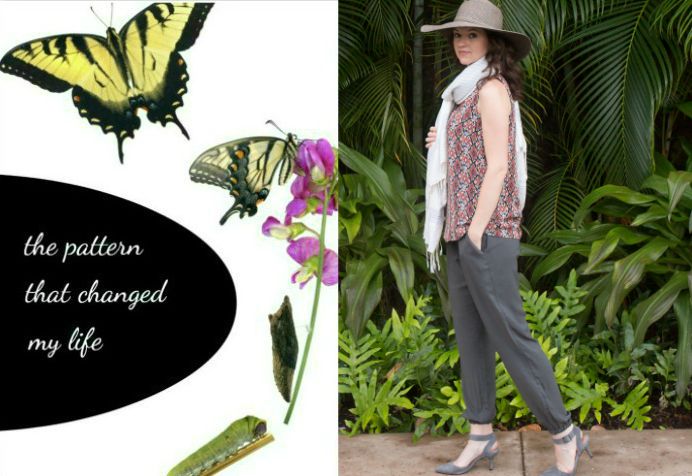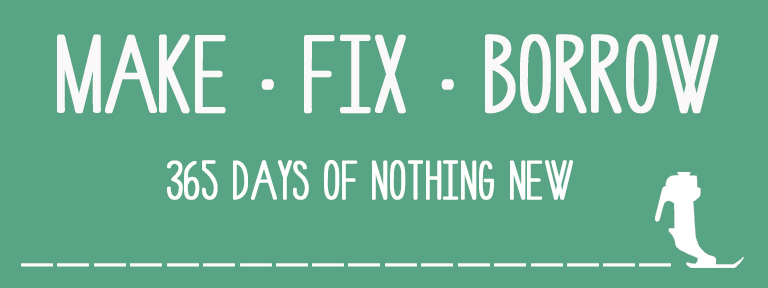Each week throughout the summer we’ll hear from a designer about a pattern or book that caused them to head in a new direction and helped form their career. It’s the pattern that changed their life.
Allie Olson is the co-founder of the women’s sewing community, Indiesew.com. She’s passionate about garment sewing and keeping creativity the top priority in her life. Allie curates Indiesew’s sewing pattern selection and fabric shop. She also writes easy-to-understand sewing tutorials to to take the frustration out of sewing your own clothes.
Allie guest posted here once before. In December she shared how Indiesew became VAT compliant at a time when all of us who sell digital files were trying to figure out how to deal with the EU’s new tax regulations.
I continue to be impressed with Indiesew’s professionalism and polish and I feel so lucky to have become friendly with Allie. I’m excited to have her visiting the blog today to share the story of the pattern (or book, in this case) that changed her life.
Here’s Allie:
It was the fall of 2011 and I was a broke graduate student looking for a distraction from my corporate accounting and statistics classes. I had just moved to Boulder for an MBA program and I found the schedule of a grad student quite flexible.
When not in class or working on group projects, I spent my time thrifting and sewing. I had a love for repurposing loud, obnoxious clothing I found at my local Goodwill and Savers. I even sewed a few garments from scratch using indie sewing patterns. And my sewing skills started to noticeably improve.
I also loved to write and show off my creations, so it seemed inevitable that I would start a sewing blog. I called it Meadow Rue. It never garnered much traffic and certainly didn’t make me any money. But I was smitten with the idea of showing off my home-sewn and repurposed garments to strangers who were surprisingly supportive. It was through Meadow Rue that I met some of my best blogging buddies to this day.
As a way to gain a larger following and also challenge myself, I decided to start a project I called “A Year of Nothing New” on July 1, 2012. My goal was simple: I would buy not a single new item (save for toiletries, food, and paper products) for an entire year. In truth, I wanted to see if I could really do it.
During this year, I started thrifting even more and borrowed other items I needed from friends. I was forced to be resourceful and creative, and I loved the challenge. But I started to identify some obvious patterns from my former life; disturbing patterns. For instance, I quickly identified my habit of binge shopping at Target when I was bored. I realized that I always ordered extra things from Amazon to justify buying toothpaste online. The way I had previously consumed items, and then simply threw them away, started to bother me.
During this yearlong challenge I read a book that changed my life. I bought Overdressed secondhand after reading some glowing online reviews and finished it in just a few days. At a time when I had a million questions around how, as a society, we consume fashion, this book answered them all.
In Overdressed, Elizabeth Cline discusses the many and varied problems with the fast fashion industry. She argues that cheap fashion typically equates to cheap labor, shoddy materials, and environmental damage. She explains how we as consumers buy these cheap clothes without giving a second thought to the ethics of the company who sells them. Then we wear those clothes out and throw them away.
Cline did some serious research on the conditions of factories in countries like China, Bangladesh, and Pakistan for this book. She traveled under the guise of a fashion designer looking to get her pieces manufactured. She painstakingly details how so many of the people who make our cheap clothes are working in utterly unsafe conditions. Her stories are shocking, to say the least.
Allie modeling clothing she’s made herself.
As the book comes to a close, Cline shifts the book’s focus to the home sewist. She profiles a few ladies who have chosen to take themselves out of the fast fashion equation. Cline even learns to sew herself. She says, “Sewing gives back a feeling of agency and self-sufficiency…I’m not sure if I’ll ever make all or even most of what I wear…but learning to sew promised to shift the way I think about clothing.”
Those words hit home for me. I knew I loved repurposing clothing and sewing new garments from scratch. But I hadn’t fully realized the pride I felt when wearing a handmade garment. I cared for my handmade clothing so much better than my crappy Target t-shirts, almost lovingly. But I hadn’t made the connection that sewing truly did give me sense of self-sufficiency. In that moment, I realized sewing was part of me, indivisible from my identity. When my Year of Nothing New ended, I didn’t rush out to buy a new wardrobe. In fact, I couldn’t stomach the thought of it.
Allie showing off a handmade dress.
I graduated and traveled for a few months after school was over. But the words of Elizabeth Cline were often on my mind. When I returned home, I fought jet lag for a few days by sewing a new skirt in the wee hours of the morning. It was during one of those late-night sewing sessions that I decided I didn’t just want to be casually involved in the handmade trend; it needed to be my career.
That evening, the initial idea for Indiesew was born. And though the business model changed over several iterations, Indiesew has always embodied my values for a handmade wardrobe, and for self-sufficiency and self-expression. Yes, sewing is a way to take ourselves out of the equation of fast fashion, but it’s also a way to show the world who we are. Like Cline says, “sewing made me realize I could dress exactly how I wanted.”
Allie wearing a piece from her handmade wardrobe.
We all have so many different reasons underlying our love of this hobby. I don’t think that being able to sew means you should, without question, make every garment you wear. But if you’re looking for a challenge, transitioning to a mostly handmade wardrobe, like the ones on the Plus Size Clothing Online, is a great way to stretch yourself. It might even change the way you consume fashion.
I’m sure I would have unearthed my passion for a handmade wardrobe without reading Overdressed…eventually. But Cline’s words said exactly what my heart had been feeling for a few years. And it gave me the confidence to do something about it, to start a business around ideas and feelings that get me out of bed every morning. For that, I’m so grateful.
+++++
Overdressed by Elizabeth Cline was the book that changed Allie Olson’s life and prompted her to start Indiesew.





Thanks for this post. I just saw “The True Cost” documentary on Netflix and want to sew all my clothes myself. I will definitely read “Over Dressed” and follow Indie Sew. The Fashion Industry is a scary world and we should recognize the impact of fast fashion has on people lives and the environment. http://www.diyordie.club
Great post, I sew, but now I am wondering about all the cheap fabric you can buy online. I am thinking I need to switch to only us made even though it’s more expensive.
As an aspiring fashion designer, I love the sense of accomplishment that goes with making your own clothes or making them for a client. That feeling that they chose YOU over Walmart or Target is nice.
I’ve read that book-heard about it via Liesl Gibson of Oliver + S.
My challenge is to convince my teen and tween girls that fast fashion isn’t the best path to real style.
Good for you! I wonder if you research where your fabric is coming from? (and I do apologize if you addressed this and I missed it) The same places that turn out cheap clothing also turn out cheap fabrics. It can be a challenge to research this stuff but only when we make a point with our dollars spent will the producers realize that we will only support sustainable and fair trade. Organic cotton (better for the farmer, better for the planet) is a case in point. It used to be very hard to find a nice selection of organic cottons, today there are many. My personal challenge is to use up my stash (all kinds of fabrics) before buying more fabrics, and when I do buy it is for sustainable, organic, fair trade or made in USA textiles and processed fibers. There are actually some nice choices at various web stores and they do have sales and clearance items.
Loved this story. I have recently thought about making some clothing that I can’t find anywhere but can envision. Instead of following this thought, I just keep busy on all “my projects.” Thanks for reminding me that it may be time to get started.
Excellent post. Sewing & repurposing is the first step to tackling this horrible problem. If one can’t sew, look for Made in USA. Yes, often fabric is imported but we need to start some where.